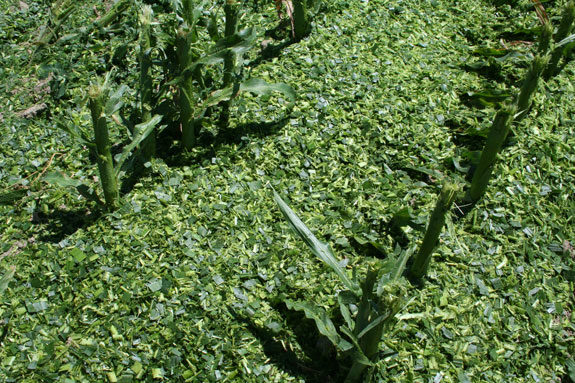Many growers today are looking for ways to maximize corn yields and on-farm profitability, whether that means increasing milk production, reducing ration costs or boosting weight gain in beef cattle. However, when it comes to corn silage, sometimes less can be more.
Recent university research shows that although increasing silage chop height reduces tonnage, it also can improve feed value significantly.
Penn State University did a summary of research trials, most of which were conducted by Pioneer. Across all trials, going from approximately 7 to 20 inches, neutral detergent fiber digestibility improved by about 5 percentage units. That is a nice improvement in digestibility for leaving indigestible stalk in the field.
As with many cultural practices in farming, increased digestibility comes with a tradeoff.
It’s true when you chop corn higher, you will take a yield hit. The general rule of thumb is for every 4 inches the cutter bar is raised, there will be a loss of about 1 ton of 30 percent dry matter silage per acre.
The challenge for growers is to weigh the benefits of improved feed quality versus the cost of lost yield. I compare the decision-making process to knowing when to cut alfalfa.
Corn is similar to alfalfa, as you give up tonnage to improve quality. If you wanted to maximize yield in alfalfa, you would let every stand go to full flower.
But you don’t. You take it anywhere from bud to 10th bloom to maximize digestibility. In many situations, it is worth it to improve the fiber digestibility, even though tonnage is lost.
High-chopping also requires a few adjustments in a producer’s feed-management strategy.
Recognize that when high-chopping, the starch level in corn silage is going to increase, because it’s going to be more concentrated in the end crop.
Fiber digestibility will increase, so you also need to be sure there is adequate physically effective NDF or scratch in the ration.
Once you have a good feel for the feeding parameters – the starch content and fiber digestibility – nutritionists should be able to work in the ration.
What is the best height for chopping? It depends. Growers in different parts of the country chop from a couple of inches to 10 inches off the ground, with 10 inches being the standard.
It is best to chop no higher than 24 inches, because it will disrupt the flow of silage through the chopper.
The optimum chop height is based on what you already have in storage for your forage supply. If you have a great first-cut alfalfa but the quality is low, you may want to consider optimizing fiber digestibility in corn silage.
So it is really farm-by-farm dependent. How much greater is the need for tonnage versus quality? That is something the dairyman and nutritionist need to explore together.
Also keep in mind that digestibility can vary among hybrids and between fields.
One way to determine optimum chop height is to hand-chop some plants at various heights. One dairyman chopped two different hybrids at both 10 inches and 22 inches.
Samples were sent to the lab quickly, and a fiber digestibility test was run to see what kind of growing season Mother Nature provided and how it affected fiber digestibility.
These numbers then were used to determine optimum cutting height for that field. Unfortunately, there is not one standard number to arrive at when the cutter bar is raised.
However, growers who do their homework and adjust chop height accordingly will go a long way toward maximizing the return on their silage investment. FG
Photo by FG staff.
Dr. Bill Mahanna
Nutrition Sciences Manager
Pioneer












